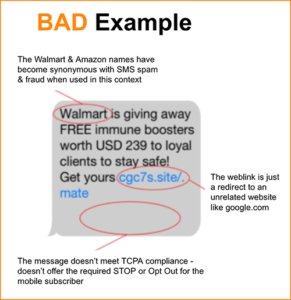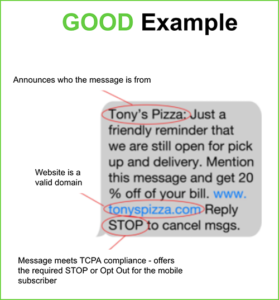New Requirements and Some Advice
from Commio’s SMS/MMS Experts
Texting is a wonderful way to reach someone, with everyone opening messages within minutes, and it’s come a long way (you know, since like, yesterday) from its short code SMS origins. Now you can include pictures, links—video!—and you don’t have to watch your character count. As with anything popular, though, fraudsters and iffy marketers jump in to ruin it for the rest of us. There are so many rules these days, senders have become nervous.
To be fair, there are quite a few. The Telephone Consumer Protection Act (TCPA) and the CTIA (an industry trade group) have rules, carriers have rules, providers have rules (Commio’s are here), there are brand and campaign registries…yikes! Ignore them and your messages might not get delivered—or worse. In fact, Commio’s rules are built into the customer contract.
Are the rules really that daunting, though? We don’t think so, if your business is legit and you use some common sense. To be on the safe side, though, here’s a list of do’s, don’ts, and never evers—starting with the legalities.
Industry Requirements—Don’t be a Spammer!
The telecom industry wants to maintain a positive reputation and avoid issues with the feds. Consumers don’t want their in-box clogged with junk or, worse, fraudulent offers. It’s a win-win! Although the official rules can contain legal mumbo-jumbo, they’re pretty basic.
 1. Opt-ins Only
1. Opt-ins Only
Make sure you receive consent from everyone on your list before sending any messages. (Here’s how.) People want what they want, and not what they don’t.
2. Signatures
Clearly mention your brand or company name in every message. Anonymous senders are…questionable.
3. What They Get
When you ask people to opt in, tell them what kinds of messages to expect; and when they do opt-in, send a welcome text that reiterates it. Then, stick to it.
4. Frequency
In that welcome message, also mention how often they can expect to hear from you, e.g., “We’ll send you coupons and new product alerts 2-3 times / month.” Again, stick to it. (And don’t send all three messages on day one!)
5. Fees
Disclose possible carrier costs and fees. You don’t have to know the amount, but mentioning the possibility will help verify you’re on the up and up. Most commonly it’s something like “Msg&Data rates may apply.”
 6. Opt-outs
6. Opt-outs
Include an option in every message (or most) to allow people to opt out of future texts. This is a fairly universal rule among good senders and providers, including Commio: “Text STOP to opt out” or just “STOP2QUIT.” The HELP option is a nice touch, too. Although it might seem like you’re making it easy for people to dump you on a bad hair day, it’s reassuring for people to know that they can if they wish. (It’s also worth noting that when I get spam, it never has an opt-out. Not once.)
7. Absolutely No SHAFT
Yes, people make fun of the acronym but it’s easy to remember and a big no-no, as in, NO Sex | Hate | Alcohol | Firearms | Tobacco. If you’re in the cigarette business, it’s unfortunate, but you’re undoubtedly used to getting your marketing hands slapped. Sorry! (Skip other questionable topics like gambling, too.)
8. Privacy Policies
This is one you might not think of, but you can’t share text subscriber data with third parties—and legitimate senders state this clearly in their privacy policy. If you’re called out for some questionable messaging, this is one place authorities look, and in many cases you’ll be asked for a link to your privacy policy during the setup process. If this isn’t spelled out, expect to not be approved for sending.
9. Registration
Register your brands and campaigns if you’ll be using long codes (better known as 10DLC). This has gotten attention recently as carriers continually change their 10DLC requirements. You can register directly in our platform or via API, and our team is happy to walk you through it (here’s a quick how-to video).
Don’t forget, short code and toll-free are also great options; watch our SMS Success webinar on-demand or contact your provider to learn more about which transmission vehicle is most ideal for your use case.
Some Other “Do’s”
These aren’t “rules” per se, but good marketing and good business:
- Do check in on your opt-ins periodically. Do they still want your messages? Do they have feedback? This best practice will keep your list clean and help if you ever get questioned.
- Do get white-listed if sending toll-free messaging; providers can help with this.
- Do consider your audience—Use their language and make your message relevant to their interests. Ideally, use keywords that align with your brand. For example, “Type DONUTS for our current flavors.”
- Do state the purpose of your message, and include a call to action. While this might seem obvious, we all receive head scratchers from time to time. Of course, everyone’s favorite is a product discount. Also? This is not the medium for multiple calls to action.
- Do know your ideal send times. No one wants to be awakened by your 10% off…they might opt out. They’ll certainly think you’re a bozo. (In fact, the TCPA has definite ideas on when Not to send.) Better to hit them at the exact time they’re most likely to click through and buy.
- Do keep it short and sweet—these are texts, not novels. Consumers value SMS marketing because it’s a quick read. When you send too much / too often you begin to lose them, especially when you can insert a link “for more info.”
- Do provide content unique to your texts (i.e., not also in your emails, newsletters, etc.) Super-timely offers (“One day sale!”) and updates are good options. Otherwise, people have no reason to subscribe to all your communications.
Aaand, Just a Few Don’ts
- Don’t “shout” much, because…shouting. Who likes a shouter? (If you’re over 40, shouting means words or sentences IN ALL CAPS, LIKE THIS. However, reply options—“Type HELP”—are fine!) As with any marketing message, tone is important for conversions; in the case of SMS marketing, it alsos minimize the risk of complaints to carriers.
- Don’t include lengthy URLs. You want to use your verified and registered domain (with a current security certificate), which ideally matches your landing page, but do keep the overall length as short as possible.
- Don’t use texting-speak and acronyms—IKR?! Sure, lots of people might know them, but unless you’re, say, a surfboard shop with a very distinct audience of young, hip people, why risk losing people over acronyms?
- Don’t send to anyone who hasn’t opted in. Hopefully this has been made clear? And now we’ve come full circle…
Much of this list is common sense to seasoned marketers. At the end of the day, it’s all about ensuring your messages go through. Commio is working hard to ensure that customers’ messaging needs are met, while also helping to restore communications integrity for both voice and messaging. If you have questions about what does or does not work, contact us and get sending!
See also: eBook Introduction | Short Code | Long Code | Toll-Free Messaging | Opt-In Lists | Messaging Rules | Delivery Receipts (DLRs) | Messaging APIs
















